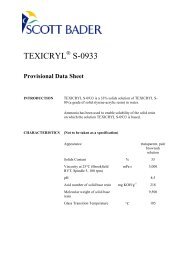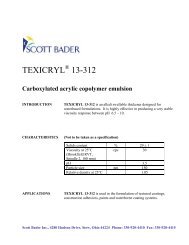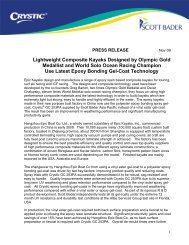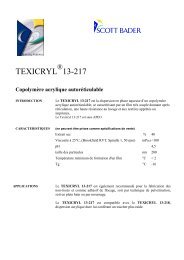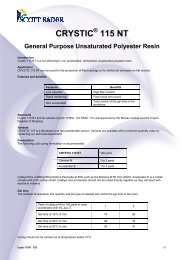Crestabond M7-15 - English - Scott Bader
Crestabond M7-15 - English - Scott Bader
Crestabond M7-15 - English - Scott Bader
Create successful ePaper yourself
Turn your PDF publications into a flip-book with our unique Google optimized e-Paper software.
Bond Joint Strength – Typical Lap Shear Strengths<br />
(MPa) at 23°C<br />
Values are based on substrate failure where marked by *<br />
GRP/FRP*<br />
PVC<br />
ABS<br />
Cold Rolled Steel<br />
Aluminium<br />
Galvanised<br />
Acrylic<br />
0 5 10 <strong>15</strong> 20 25<br />
Lap Shear Strength (MPa)<br />
Material Surface Preparation<br />
Bondline<br />
Thickness<br />
Test Method<br />
GRP Solvent Degrease 3.00mm ASTM 5868<br />
PVC Solvent Degrease 0.76mm ASTM 2564<br />
ABS Solvent Degrease 0.76mm ASTM 2564<br />
Cold Rolled Steel<br />
Degrease, Abrade &<br />
Degrease<br />
0.26mm ISO 4587<br />
Aluminium Solvent Degrease 0.26mm ISO 4587<br />
Galvanised Steel Solvent Degrease 0.26mm ISO 4587<br />
Acrylic Solvent Degrease 0.76mm ASTM 2564<br />
Please contact <strong>Scott</strong> <strong>Bader</strong> Technical Services for information on other substrates.<br />
Temperature Performance Lap Shear Testing<br />
Tested to ISO 4587:2003 0.26mm bondline, aluminium<br />
6061-T6, acetone wipe surface preparation.<br />
Working Time Testing<br />
The time taken for a 12g mass to reach 30°C at different<br />
ambient temperatures.<br />
Lap Shear Strength (MPa)<br />
30<br />
25<br />
20<br />
<strong>15</strong><br />
10<br />
5<br />
Working Time (Mins: Sec)<br />
38:00<br />
33:00<br />
28:00<br />
23:00<br />
18:00<br />
13:00<br />
08:00<br />
0<br />
-40 -20 0 23 40 60 80 100<br />
Temperature (°C)<br />
03:00<br />
18 20 22 24 26 28 30<br />
Temperature (°C)<br />
Recommended Substrates<br />
Metals Thermoplastics Composites<br />
Aluminium<br />
Stainless Steel<br />
Carbon Steel<br />
Powder Coated Metals<br />
Galvanised/Zinc Coated Metals<br />
Acrylic<br />
Styrenics<br />
ABS<br />
PVC/CPVC<br />
GRP/FRP<br />
Epoxy 3<br />
Polyester & DCPD Modified<br />
Vinyl Esters<br />
Urethanes<br />
Gel Coats 4<br />
Carbon Fibre<br />
3. Surface preparation of epoxy laminates may be necessary and testing should be performed to ensure sufficient bond<br />
strength is achieved.<br />
4. Surface preparation is likely to be needed on gel coat surface to ensure no release agents are present.<br />
Please contact <strong>Scott</strong> <strong>Bader</strong> Technical Services for information on other substrates and advice.<br />
Surface Preparation<br />
The surface to be bonded can affect the strength and durability of the bond joint. Appropriate treatment may be required<br />
to ensure that there are no traces of oil, grease or dirt through the use of a degreasing agent, for instance acetone or<br />
another degreasing agent on the joint surfaces.<br />
Mechanically abrading or chemically etching degreased surfaces can make bond joints more durable and stronger. If<br />
abrading, a second treatment of degreasing is required.<br />
Do not use gasoline (petrol), low grade alcohol or paint thinners.<br />
i) Metals<br />
The surface should be clean and dry by using an alcohol/solvent wipe and allowing the solvent to evaporate before<br />
application.<br />
<strong>Crestabond</strong> ® <strong>M7</strong>-<strong>15</strong> – TDS 2/3





